Lagaan: A Historical Analysis of Relationships, Caste, Colonialism
VerifiedAdded on 2023/06/08
|5
|989
|354
Essay
AI Summary
This essay provides a comprehensive analysis of the historical context within the film Lagaan, exploring key themes such as the portrayal of relationships, the impact of caste discrimination, and the effects of British colonialism on India. It examines the strong bond between Bhuvan and his mother, the discrimination faced by lower caste individuals like Kachra, and the oppressive nature of British rule and taxation policies. The essay also highlights the contrasting portrayals of British characters, distinguishing between the tyrannical officer Russell and the supportive Elizabeth, who aids the villagers and challenges the unjust tax system. Ultimately, the analysis emphasizes the film's depiction of unity, resistance, and the consequences of underestimating the oppressed, demonstrating how Lagaan serves as a powerful commentary on historical and social dynamics.
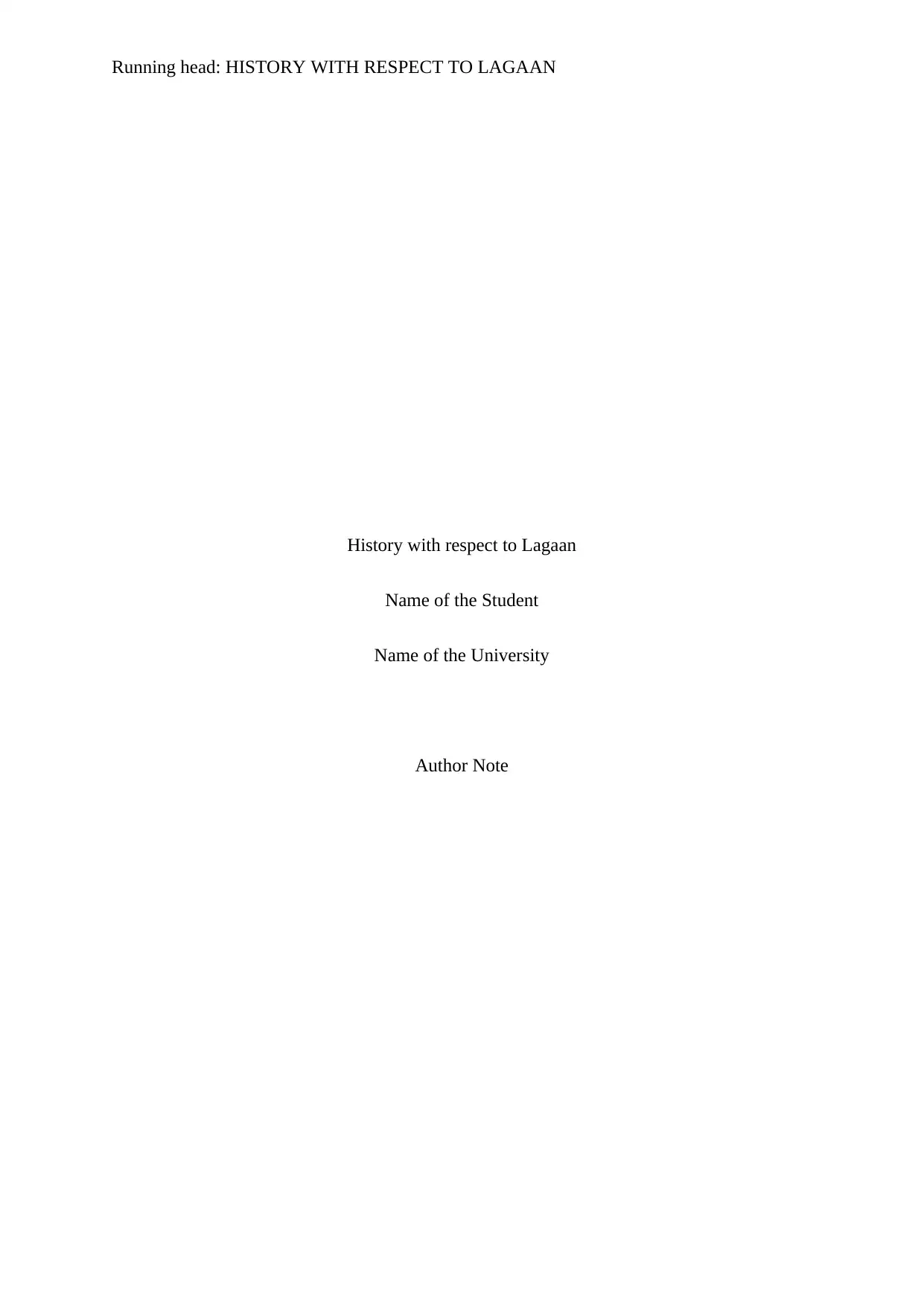
Running head: HISTORY WITH RESPECT TO LAGAAN
History with respect to Lagaan
Name of the Student
Name of the University
Author Note
History with respect to Lagaan
Name of the Student
Name of the University
Author Note
Paraphrase This Document
Need a fresh take? Get an instant paraphrase of this document with our AI Paraphraser
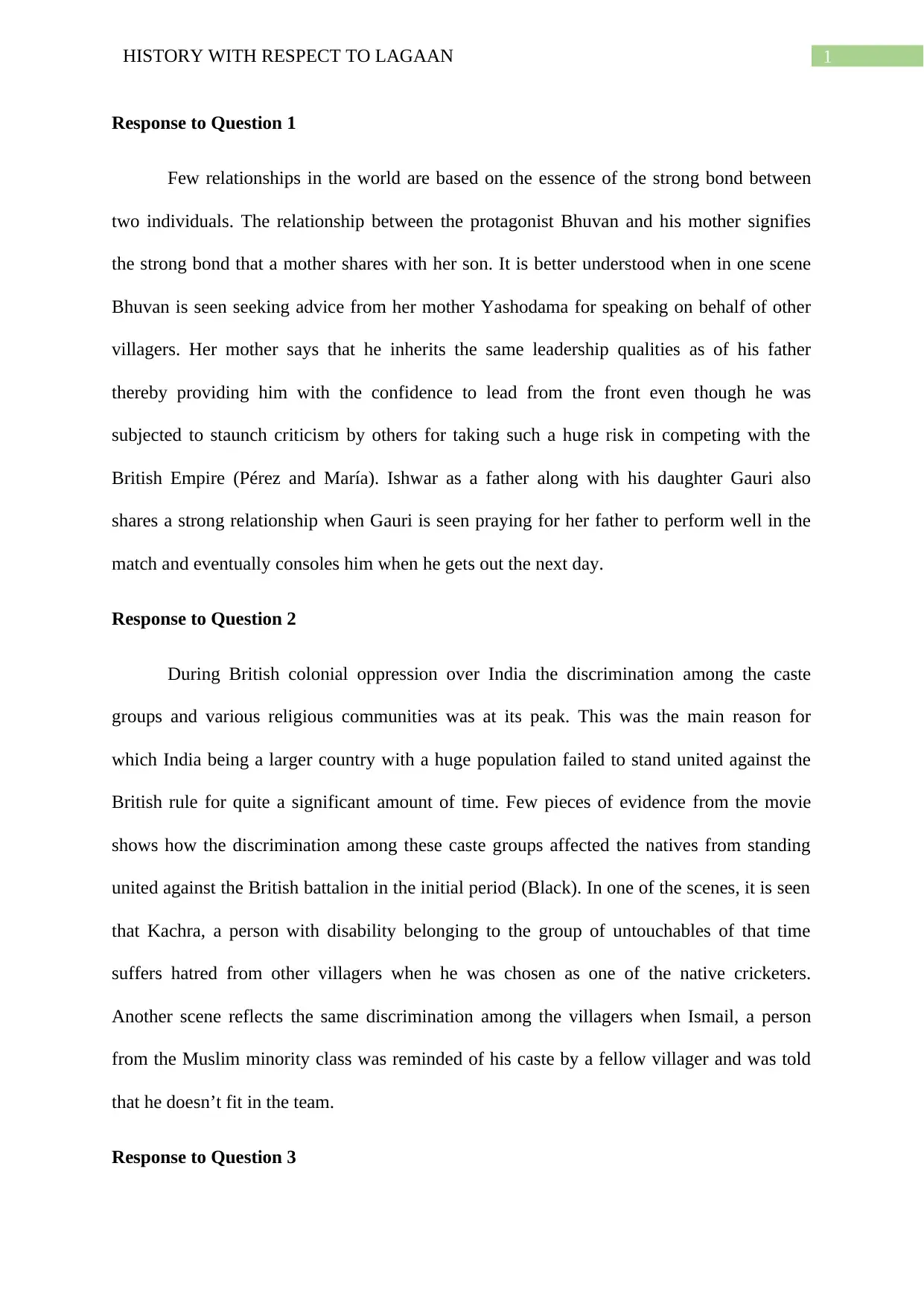
1HISTORY WITH RESPECT TO LAGAAN
Response to Question 1
Few relationships in the world are based on the essence of the strong bond between
two individuals. The relationship between the protagonist Bhuvan and his mother signifies
the strong bond that a mother shares with her son. It is better understood when in one scene
Bhuvan is seen seeking advice from her mother Yashodama for speaking on behalf of other
villagers. Her mother says that he inherits the same leadership qualities as of his father
thereby providing him with the confidence to lead from the front even though he was
subjected to staunch criticism by others for taking such a huge risk in competing with the
British Empire (Pérez and María). Ishwar as a father along with his daughter Gauri also
shares a strong relationship when Gauri is seen praying for her father to perform well in the
match and eventually consoles him when he gets out the next day.
Response to Question 2
During British colonial oppression over India the discrimination among the caste
groups and various religious communities was at its peak. This was the main reason for
which India being a larger country with a huge population failed to stand united against the
British rule for quite a significant amount of time. Few pieces of evidence from the movie
shows how the discrimination among these caste groups affected the natives from standing
united against the British battalion in the initial period (Black). In one of the scenes, it is seen
that Kachra, a person with disability belonging to the group of untouchables of that time
suffers hatred from other villagers when he was chosen as one of the native cricketers.
Another scene reflects the same discrimination among the villagers when Ismail, a person
from the Muslim minority class was reminded of his caste by a fellow villager and was told
that he doesn’t fit in the team.
Response to Question 3
Response to Question 1
Few relationships in the world are based on the essence of the strong bond between
two individuals. The relationship between the protagonist Bhuvan and his mother signifies
the strong bond that a mother shares with her son. It is better understood when in one scene
Bhuvan is seen seeking advice from her mother Yashodama for speaking on behalf of other
villagers. Her mother says that he inherits the same leadership qualities as of his father
thereby providing him with the confidence to lead from the front even though he was
subjected to staunch criticism by others for taking such a huge risk in competing with the
British Empire (Pérez and María). Ishwar as a father along with his daughter Gauri also
shares a strong relationship when Gauri is seen praying for her father to perform well in the
match and eventually consoles him when he gets out the next day.
Response to Question 2
During British colonial oppression over India the discrimination among the caste
groups and various religious communities was at its peak. This was the main reason for
which India being a larger country with a huge population failed to stand united against the
British rule for quite a significant amount of time. Few pieces of evidence from the movie
shows how the discrimination among these caste groups affected the natives from standing
united against the British battalion in the initial period (Black). In one of the scenes, it is seen
that Kachra, a person with disability belonging to the group of untouchables of that time
suffers hatred from other villagers when he was chosen as one of the native cricketers.
Another scene reflects the same discrimination among the villagers when Ismail, a person
from the Muslim minority class was reminded of his caste by a fellow villager and was told
that he doesn’t fit in the team.
Response to Question 3
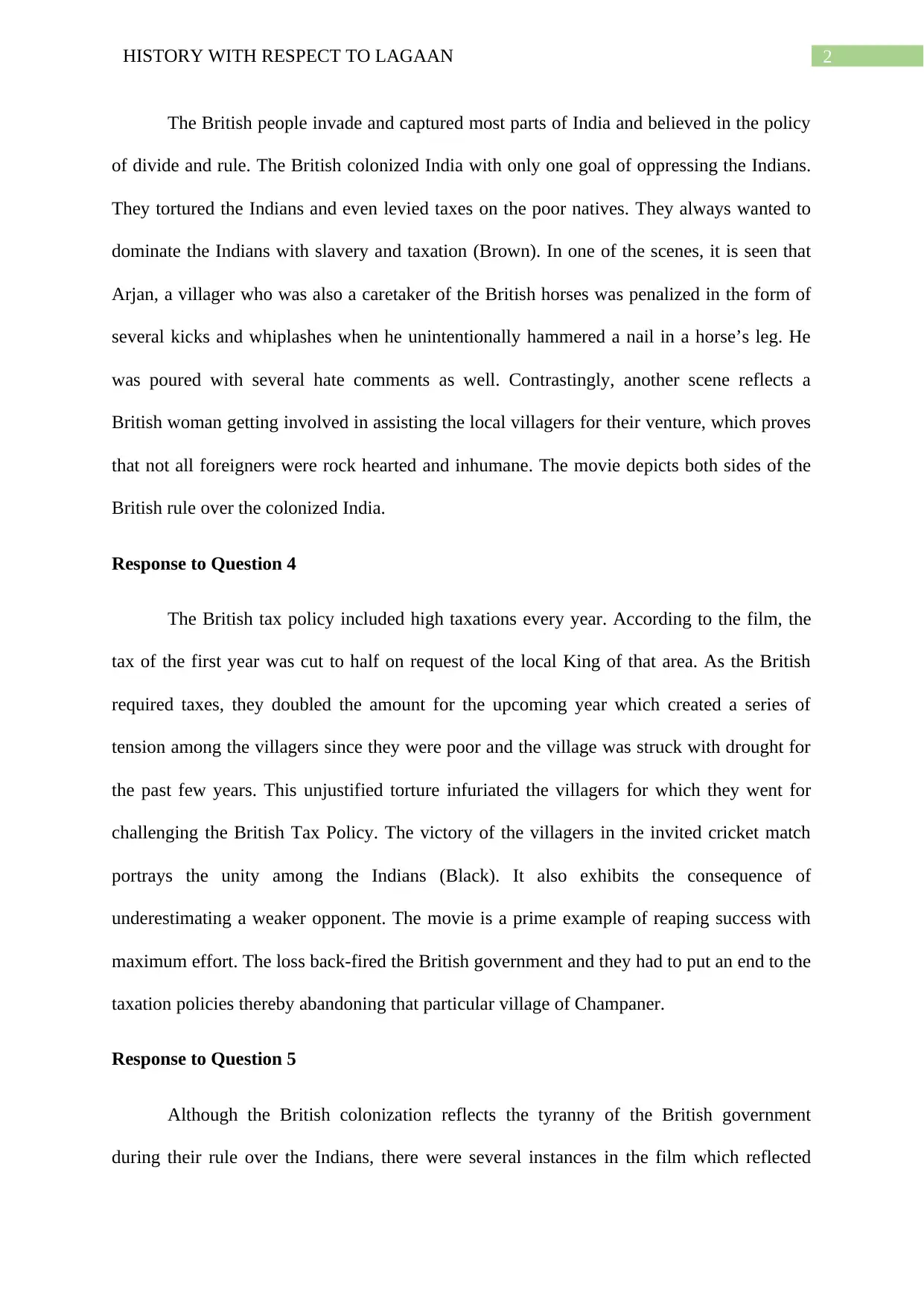
2HISTORY WITH RESPECT TO LAGAAN
The British people invade and captured most parts of India and believed in the policy
of divide and rule. The British colonized India with only one goal of oppressing the Indians.
They tortured the Indians and even levied taxes on the poor natives. They always wanted to
dominate the Indians with slavery and taxation (Brown). In one of the scenes, it is seen that
Arjan, a villager who was also a caretaker of the British horses was penalized in the form of
several kicks and whiplashes when he unintentionally hammered a nail in a horse’s leg. He
was poured with several hate comments as well. Contrastingly, another scene reflects a
British woman getting involved in assisting the local villagers for their venture, which proves
that not all foreigners were rock hearted and inhumane. The movie depicts both sides of the
British rule over the colonized India.
Response to Question 4
The British tax policy included high taxations every year. According to the film, the
tax of the first year was cut to half on request of the local King of that area. As the British
required taxes, they doubled the amount for the upcoming year which created a series of
tension among the villagers since they were poor and the village was struck with drought for
the past few years. This unjustified torture infuriated the villagers for which they went for
challenging the British Tax Policy. The victory of the villagers in the invited cricket match
portrays the unity among the Indians (Black). It also exhibits the consequence of
underestimating a weaker opponent. The movie is a prime example of reaping success with
maximum effort. The loss back-fired the British government and they had to put an end to the
taxation policies thereby abandoning that particular village of Champaner.
Response to Question 5
Although the British colonization reflects the tyranny of the British government
during their rule over the Indians, there were several instances in the film which reflected
The British people invade and captured most parts of India and believed in the policy
of divide and rule. The British colonized India with only one goal of oppressing the Indians.
They tortured the Indians and even levied taxes on the poor natives. They always wanted to
dominate the Indians with slavery and taxation (Brown). In one of the scenes, it is seen that
Arjan, a villager who was also a caretaker of the British horses was penalized in the form of
several kicks and whiplashes when he unintentionally hammered a nail in a horse’s leg. He
was poured with several hate comments as well. Contrastingly, another scene reflects a
British woman getting involved in assisting the local villagers for their venture, which proves
that not all foreigners were rock hearted and inhumane. The movie depicts both sides of the
British rule over the colonized India.
Response to Question 4
The British tax policy included high taxations every year. According to the film, the
tax of the first year was cut to half on request of the local King of that area. As the British
required taxes, they doubled the amount for the upcoming year which created a series of
tension among the villagers since they were poor and the village was struck with drought for
the past few years. This unjustified torture infuriated the villagers for which they went for
challenging the British Tax Policy. The victory of the villagers in the invited cricket match
portrays the unity among the Indians (Black). It also exhibits the consequence of
underestimating a weaker opponent. The movie is a prime example of reaping success with
maximum effort. The loss back-fired the British government and they had to put an end to the
taxation policies thereby abandoning that particular village of Champaner.
Response to Question 5
Although the British colonization reflects the tyranny of the British government
during their rule over the Indians, there were several instances in the film which reflected
⊘ This is a preview!⊘
Do you want full access?
Subscribe today to unlock all pages.

Trusted by 1+ million students worldwide
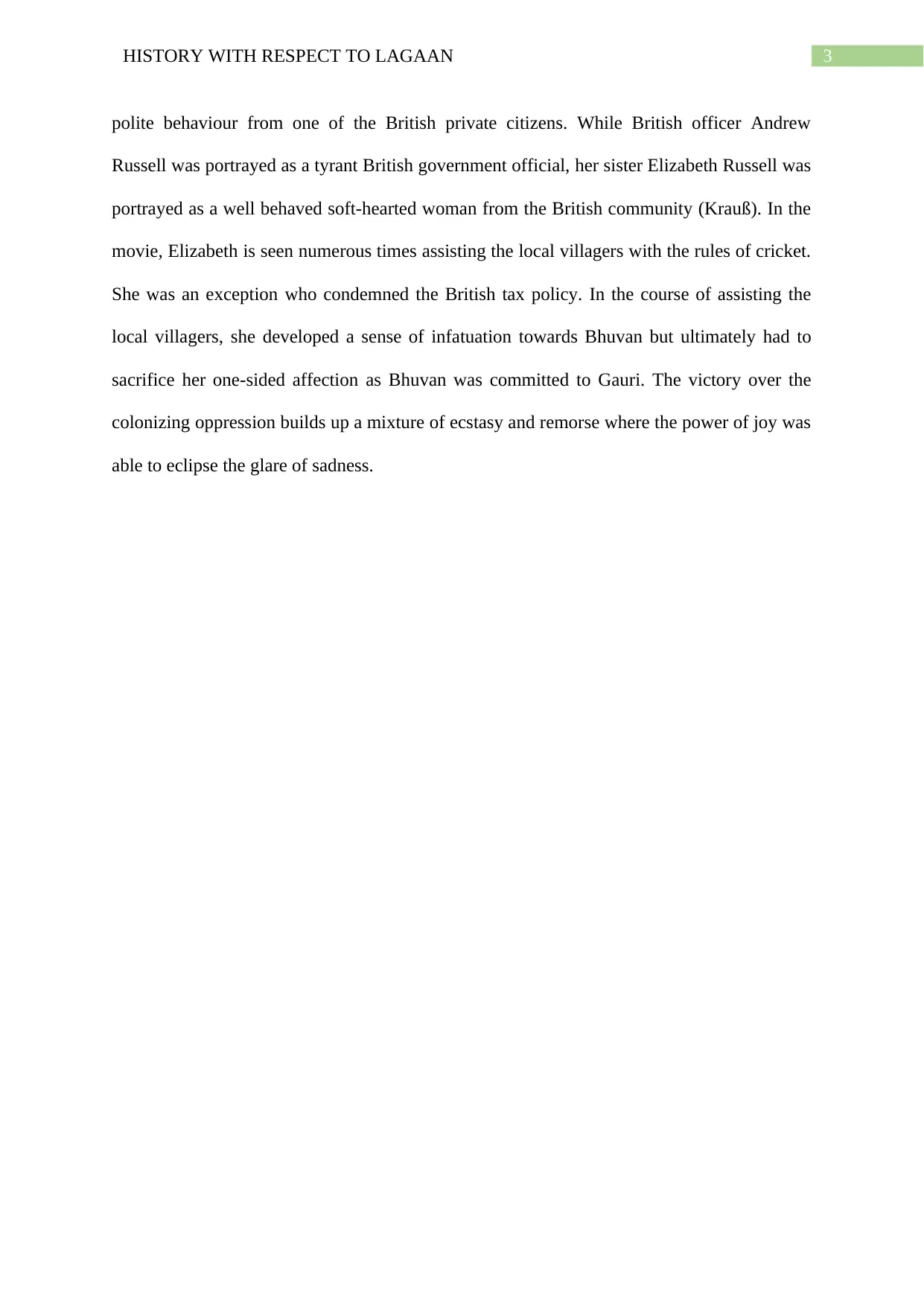
3HISTORY WITH RESPECT TO LAGAAN
polite behaviour from one of the British private citizens. While British officer Andrew
Russell was portrayed as a tyrant British government official, her sister Elizabeth Russell was
portrayed as a well behaved soft-hearted woman from the British community (Krauß). In the
movie, Elizabeth is seen numerous times assisting the local villagers with the rules of cricket.
She was an exception who condemned the British tax policy. In the course of assisting the
local villagers, she developed a sense of infatuation towards Bhuvan but ultimately had to
sacrifice her one-sided affection as Bhuvan was committed to Gauri. The victory over the
colonizing oppression builds up a mixture of ecstasy and remorse where the power of joy was
able to eclipse the glare of sadness.
polite behaviour from one of the British private citizens. While British officer Andrew
Russell was portrayed as a tyrant British government official, her sister Elizabeth Russell was
portrayed as a well behaved soft-hearted woman from the British community (Krauß). In the
movie, Elizabeth is seen numerous times assisting the local villagers with the rules of cricket.
She was an exception who condemned the British tax policy. In the course of assisting the
local villagers, she developed a sense of infatuation towards Bhuvan but ultimately had to
sacrifice her one-sided affection as Bhuvan was committed to Gauri. The victory over the
colonizing oppression builds up a mixture of ecstasy and remorse where the power of joy was
able to eclipse the glare of sadness.
Paraphrase This Document
Need a fresh take? Get an instant paraphrase of this document with our AI Paraphraser
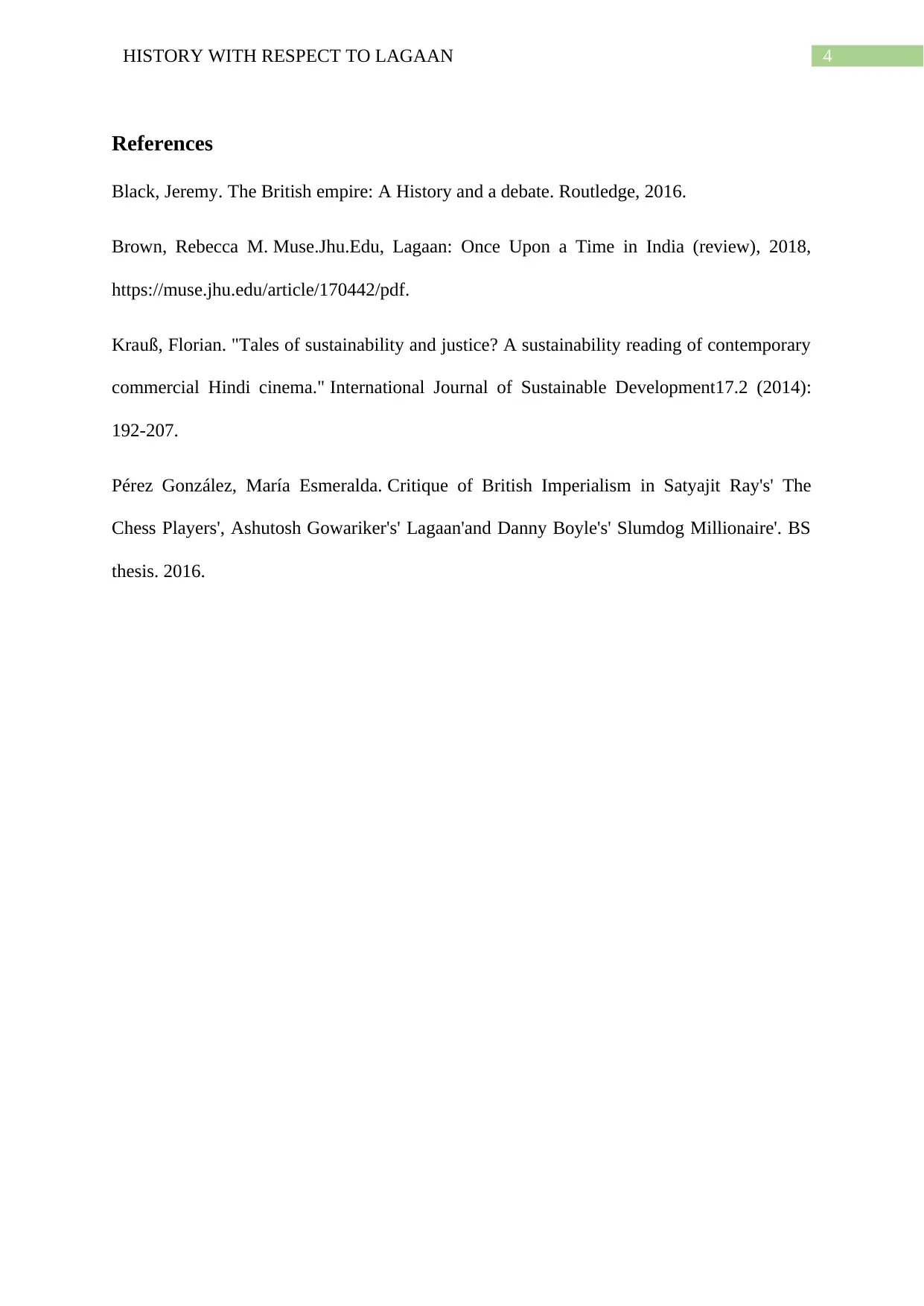
4HISTORY WITH RESPECT TO LAGAAN
References
Black, Jeremy. The British empire: A History and a debate. Routledge, 2016.
Brown, Rebecca M. Muse.Jhu.Edu, Lagaan: Once Upon a Time in India (review), 2018,
https://muse.jhu.edu/article/170442/pdf.
Krauß, Florian. "Tales of sustainability and justice? A sustainability reading of contemporary
commercial Hindi cinema." International Journal of Sustainable Development17.2 (2014):
192-207.
Pérez González, María Esmeralda. Critique of British Imperialism in Satyajit Ray's' The
Chess Players', Ashutosh Gowariker's' Lagaan'and Danny Boyle's' Slumdog Millionaire'. BS
thesis. 2016.
References
Black, Jeremy. The British empire: A History and a debate. Routledge, 2016.
Brown, Rebecca M. Muse.Jhu.Edu, Lagaan: Once Upon a Time in India (review), 2018,
https://muse.jhu.edu/article/170442/pdf.
Krauß, Florian. "Tales of sustainability and justice? A sustainability reading of contemporary
commercial Hindi cinema." International Journal of Sustainable Development17.2 (2014):
192-207.
Pérez González, María Esmeralda. Critique of British Imperialism in Satyajit Ray's' The
Chess Players', Ashutosh Gowariker's' Lagaan'and Danny Boyle's' Slumdog Millionaire'. BS
thesis. 2016.
1 out of 5
Your All-in-One AI-Powered Toolkit for Academic Success.
+13062052269
info@desklib.com
Available 24*7 on WhatsApp / Email
![[object Object]](/_next/static/media/star-bottom.7253800d.svg)
Unlock your academic potential
Copyright © 2020–2025 A2Z Services. All Rights Reserved. Developed and managed by ZUCOL.